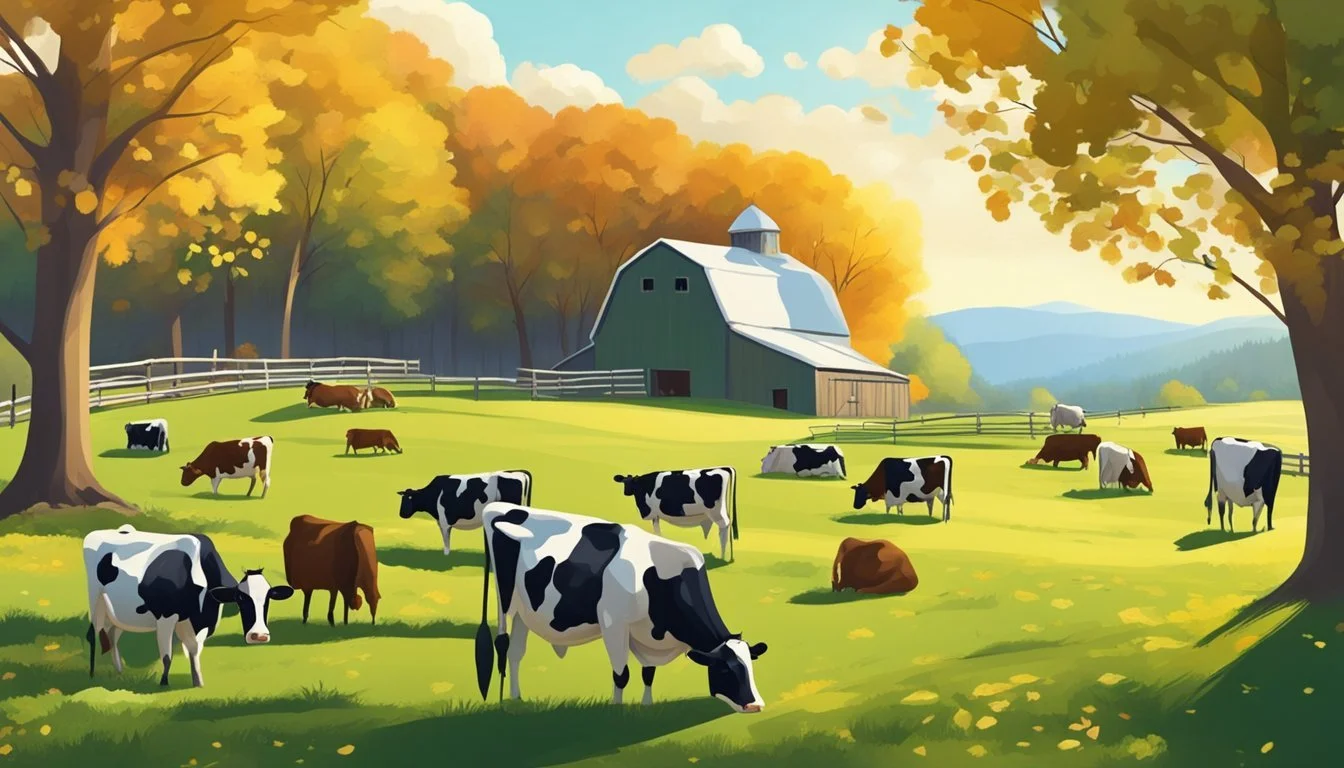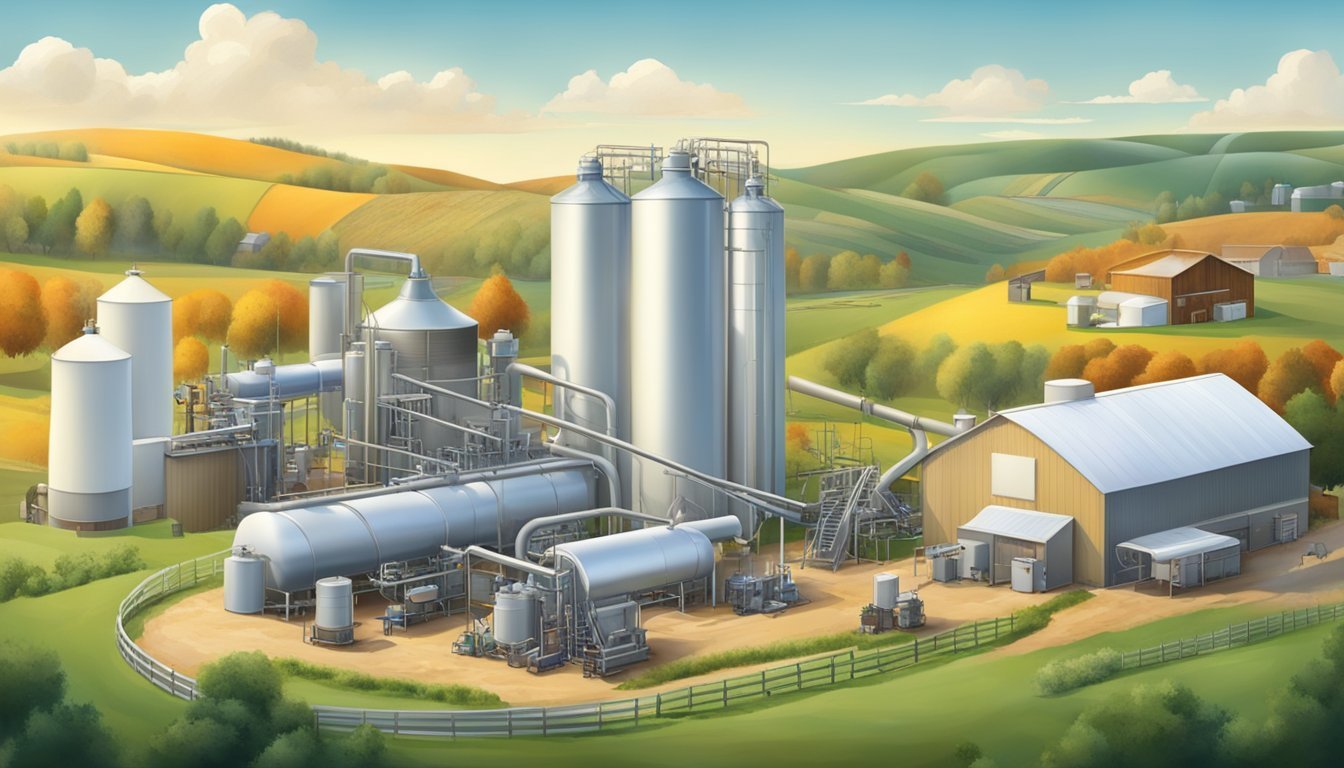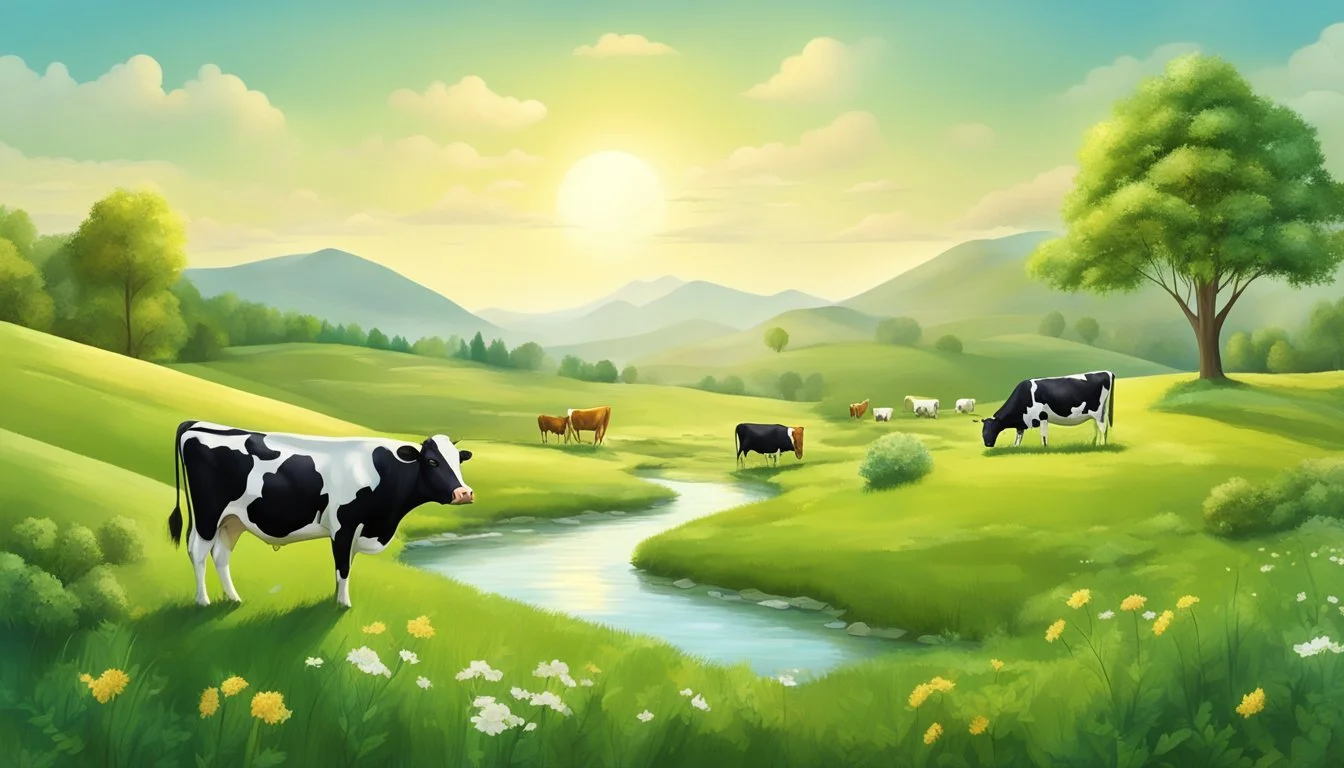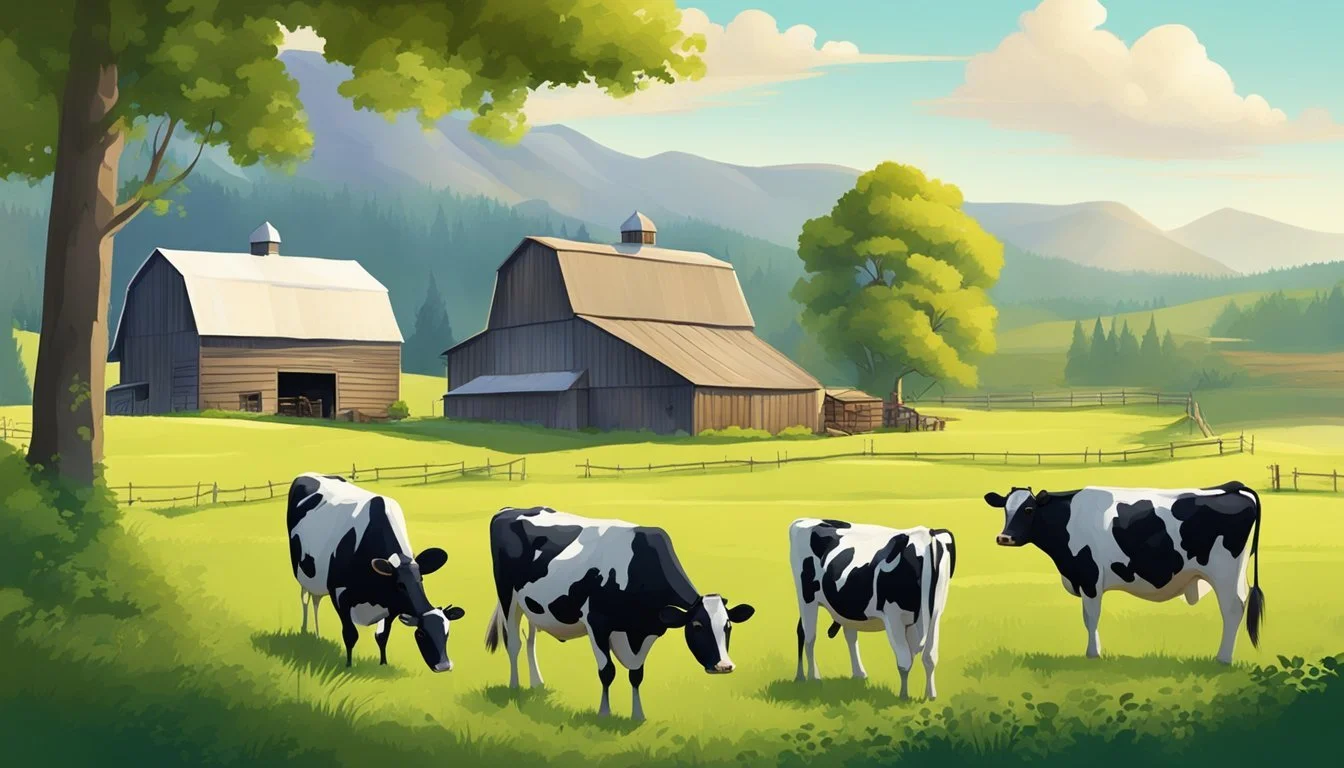Seasonal Variations in Raw Milk
Exploring Quality and Taste Fluctuations Through the Year
Seasonal variations significantly influence the quality and taste of raw milk, shaping its compositional profile throughout the year. Factors such as diet, feed quality, and stage of lactation are central to these fluctuations. During different seasons, changes in temperature, humidity, and available forage alter cows' diets and can result in variations in milk's fat, protein, and lactose content. These compositional changes not only affect the raw milk's taste but also its suitability for processing into dairy products like cheese, butter, and yogurt.
The photoperiod, or the duration of daylight, also plays a role in influencing milk composition by affecting the cows’ hormonal cycles. Research in dairy science indicates that milk density, a key quality indicator, can be subject to seasonal shifts, necessitating the creation of season-specific conversion factors for accurate milk processing. The industry must therefore adapt to these natural cycles to optimize milk handling and processing, ensuring a consistent quality of dairy products year-round.
Understanding the complexities of milk composition, and recognizing seasonal trends, allows dairy producers to fine-tune their practices to accommodate these natural variations. This knowledge is critical in maintaining the taste and quality stability of milk, presenting both challenges and opportunities for the dairy industry to innovate and improve their product offerings across seasons.
Seasonal Variations in Raw Milk offer a fascinating insight into the dynamic interplay between nature and dairy production. This exploration of raw milk cheese-making and other dairy processes sheds light on the impact of seasonal changes on the flavor, composition, and characteristics of raw milk. Moreover, it underscores the significance of considering raw milk nutritional deficiencies and how seasonal variations may influence the nutrient profile of raw milk, thus impacting its potential role in addressing dietary gaps.
Furthermore, the discussion encompasses the ethical considerations surrounding raw milk infant nutrition and the aging population, emphasizing the need for responsible and informed practices when it comes to consuming raw milk. It also delves into the diverse implications of raw milk in the context of a raw milk diet, acknowledging the cultural and nutritional significance of seasonal variations in raw milk.
In essence, Seasonal Variations in Raw Milk provides a holistic perspective on the multifaceted aspects of raw milk, encouraging a thoughtful approach to its production, consumption, and potential impact on diverse demographic groups.
Seasonal Changes and Milk Composition
The composition of raw milk undergoes various changes with the seasons, affecting its quality and taste. These modifications can be attributed to factors like diet, temperature, and cow physiology.
Raw Milk Composition
The composition of raw milk is a dynamic mix of macro components and micronutrients, which exhibits clear seasonal patterns. Seasonal variation plays a pivotal role in altering the milk composition. These changes are important for dairy producers to consider, as they can impact the processing characteristics and nutritional value of milk and its derived products.
Protein and Casein Variability
Proteins, including casein, are essential components of milk, crucial for its coagulation and the quality of cheese produced. Protein content tends to increase during colder months, possibly due to higher feed intake and lower heat stress. The variability in κ-casein impacts the milk's thermal stability and coagulation properties, which can fluctuate seasonally.
Fat Content Fluctuations
Fat content in milk also shows noticeable fluctuations throughout the year, with higher levels often observed in the colder seasons. These changes in milk fat can affect both the flavor and the texture of dairy products. The milk fatty acid composition may shift towards more unsaturated fatty acids during certain times of the year, influenced by the cow's diet and forage quality.
Lactose and Minerals Dynamics
Lactose, a vital sugar component in milk, along with minerals like calcium and phosphorus, generally remains stable. However, there can be minor variances over the seasons. Minerals' and lactose content are less affected by season compared to protein and fat, yet they play an indispensable role in the nutritional profile of milk.
Impact of Season and Temperature
Seasonal fluctuations and temperature variations are critical environmental factors that directly influence the quality and physical properties of milk. Recognizing the effects of these elements ensures a nuanced understanding of milk production.
Temperature Effects on Milk Quality
Temperature can significantly affect the quality attributes of milk, including its density, fat content, and protein levels. Studies indicate a linear correlation between temperatures and certain milk components; for instance, protein levels tend to rise with lower ambient temperatures. Conversely, higher temperatures can lead to decreased milk density, adversely impacting its overall quality.
Heat Stress on Dairy Cows
Heat stress in dairy cows due to elevated temperatures during warmer months is a pivotal concern. It can lead to alterations in the cows' physiological state, affecting their milk yield and composition. Substantial heat stress can result in lower fat and protein content in the milk. Necessary mitigations include environmental adjustments to reduce temperature extremes, thus preserving the consistency and quality of milk throughout seasonal variations.
Lactation and Breeding Factors
In the context of raw milk quality and taste, the lactation and breeding factors of dairy cows are pivotal. Specific breed characteristics and the lactation stages significantly influence milk production variables.
Holstein and Breed Variations
Holstein Friesian cows are renowned for their high milk production; however, this can sometimes be at the expense of certain milk constituents. Contrastingly, the Brown Swiss, another common dairy breed, is known for producing milk with higher butterfat and protein content but in lesser quantities. The variances between breeds can affect the milk's flavor and suitability for different dairy products.
Breed Milk Production Fat Content Protein Content Use Case Holstein High Lower Lower High-volume products Brown Swiss Moderate Higher Higher Cheese and premium dairy
Lactation Stages and Milk Production
Milk production and composition are dynamic throughout the lactation stage of a cow. The initial phase, known as colostrogenesis, produces colostrum, which is rich in nutrients and antibodies but not suitable for commercial milk products. As lactation progresses, the volume of milk increases but constituents like proteins and fats tend to decrease. Advanced lactation stages can lead to a reduction in milk yield but a richer composition in fat and protein.
Early Lactation: Peak volume with balanced composition.
Mid Lactation: High volume, slight dip in nutrients.
Late Lactation: Lower volume, enriched fat/protein content.
The stage of lactation is a critical factor considered by dairy farmers to maintain consistency in commercial milk supplies. Holstein cows generally have higher yields throughout their lactation period compared to other breeds like the Brown Swiss, which may produce milk with a denser nutrient profile. These factors are essential in determining the rationale behind breeding choices and milk production strategies within the dairy industry.
Dairy Farming and Management Practices
Effective dairy farm management and proper farming practices are critical for maintaining the quality and taste of raw milk throughout the year. These strategies are directly influenced by seasonal changes, which affect feed availability, udder health, and milking procedures.
Feeding and Pasture Management
Dairy farms adjust their feeding management by season to maintain milk quality. During the spring and summer months, cows often graze on high-quality pasture, directly influencing the fatty acid profile and flavor of the milk. Pasture-based systems, in particular, can lead to milk with higher concentrations of beneficial compounds like conjugated linoleic acid (CLA) and omega-3 fatty acids.
Reduced pasture availability
Higher reliance on stored forages and supplements
Potential for increased feed costs
Feeding Strategies for Optimal Milk:
Ensure a balanced diet to maintain milk composition
Use stored forages and adjust rations to meet nutritional needs
Monitor feed quality and adjust as necessary
Udder Health and Milking Procedures
Udder health is paramount in the dairy industry, as it directly affects milk quality and safety. Farmers implement thorough udder cleaning regimens and consistent milking procedures to reduce the risk of contamination and mastitis, an inflammation of the udder commonly caused by microbial infections.
Effective Udder Health Practices:
Regular inspection and cleaning of udders before milking
Use of teat dips or sprays post-milking to prevent infections
Consistent Milking Procedures:
Sanitization of milking equipment to maintain hygienic standards
Adherence to a routine milking schedule to support animal well-being and milk production
By focusing on specific feeding and pasture management strategies and maintaining udder health through meticulous milking procedures, the dairy industry can mitigate the impact of seasonal variations on the quality and taste of raw milk.
Technological Aspects and Processing
Technological advancements and processing methods are key to maintaining the quality of dairy products despite the inherent variability in raw milk composition throughout the year.
Milk Processing and Heat Treatment
Milk processing often involves a critical step known as heat treatment. This process is designed to ensure the milk's safety and extend its shelf life. Depending on the desired end product, processors may apply pasteurization or ultra-high temperature (UHT) methods. During pasteurization, the milk is heated to at least 72°C for 15 seconds, which eliminates a majority of harmful microorganisms. Alternatively, UHT processing heats up milk to about 135-140°C for a few seconds, offering even longer shelf life.
The specific choice of heat treatment affects the milk's sensory attributes and processing characteristics. For products like whole milk, it's essential to balance the heat application to preserve taste and nutritional content while ensuring microbial safety.
Dairy Products and Manufacture
Different dairy products require various processing parameters to achieve optimal quality. For instance, cheddar cheese manufacture is impacted by the milk's fat and protein content, which can vary seasonally. Adjusting technology and processing protocols allows manufacturers to consistently produce high-quality cheese.
Dairy foods' manufacture must account for these variations to stabilize sensory qualities and ensure uniformity in products. Processors employ adaptive technologies and techniques, like standardizing milk components before cheese making or adding processing aids to manage fluid milk's behavior during seasonal shifts in its composition.
Throughout, the focus remains on leveraging technology to adapt to raw milk's seasonal changes, ensuring the integrity and consistency of dairy offerings.
Microbiological Considerations
The microbiological quality of raw milk fluctuates seasonally, impacting its safety and characteristics. This variation is largely influenced by milk microbiota consisting of bacteria such as lactic acid bacteria, total bacteria count, coliform count, sporeforming bacteria, and enterobacteriaceae.
Milk Microbiota and Bacterial Profiles
Raw milk is inhabited by a diverse community of microorganisms known as the milk microbiota. These microbial populations include beneficial lactic acid bacteria, which can influence the fermentation process and flavor of dairy products. However, raw milk also hosts various opportunistic pathogens. Studies have shown that the microbial composition varies throughout the year. For instance, total bacteria count tends to be higher in warmer months. The presence of sporeforming bacteria changes with the feed and the health of the animals, which also can vary by season.
Coliform count is another important indicator of milk quality, often higher in warmer seasons, which is associated with the milk handling practices and hygienic conditions. Enterobacteriaceae are a family of bacteria that include both harmless and pathogenic species; fluctuations in their numbers can affect milk safety and require regular monitoring.
Safety and Public Health Implications
The seasonal variability in milk microbiota composition has direct implications for the safety of raw milk. Such variability can influence the growth of pathogenic microorganisms, making consistent safety protocols critical throughout the year. The total bacteria count is often used as an index of raw milk's microbial quality, indicating freshness and hygiene in production. Dairy farms must manage the coliform count, as it is crucial for public health; a high coliform count could indicate potential contamination and an increased risk of spoilage.
Lactic acid bacteria play a dual role by contributing to the desired organoleptic qualities of fermented milk products whilst also acting as a natural barrier to pathogen growth due to their production of lactic acid. However, elevated temperatures can lead to a rise in sporeforming bacteria, challenging the pasteurization process further down the supply chain.
By understanding these seasonal trends and the influence of different bacterial profiles on raw milk, producers can focus on targeted interventions to maintain the quality and safety of their products year-round.
Chemical and Physical Milk Properties
Seasonal changes distinctly influence the physicochemical attributes and sensory characteristics of milk, affecting its quality and suitability for dairy products.
Physicochemical Properties of Milk
Milk's physicochemical properties, such as pH, density, and the composition of lipids, vary across seasons due to differences in cattle feed, genetics, and environmental factors. Notably, protein and fat levels show seasonal trends, with fat content often peaking during colder months. This alteration stems from the cow's diet and its internal metabolic changes.
pH: It can fluctuate slightly with season, impacting milk stability and its processing capability.
Density: This property also sees variation, which in turn can affect processing outcomes.
Furthermore, the fatty acid profile of milk alters with the season, which can influence flavor and nutritional quality. The glycosylation patterns of milk proteins too are subject to change, which is significant since glycosylation can influence both milk's nutritional attributes and its processing characteristics.
Sensory and Nutritional Quality
Seasonal variations extend to the sensory and nutritional quality of milk, impacting its taste, aroma, and consumer acceptability. The calcium content and overall nutritional quality are essential for both direct consumption and processing.
Calcium Content: Important for product yield and nutritional value, can show significant variation.
Lipid Composition: Directly relates to the sensory profile of the milk, altering its taste and texture.
The milk's nutritional quality is contingent on its solid components, including proteins, fats, and minerals, which are subject to seasonal influences. Milk collected in different seasons might produce dairy products with dissimilar sensory profiles and possibly varying health benefits.
Regional and Genetic Influences
The quality and characteristics of raw cow milk are shaped significantly by regional factors, such as climate and pasture, and genetic factors specific to the cow breed. Both geography and genetics act in tandem, affecting milk constituents and nutrition in measurable ways.
Geographical Variations in Milk Quality
Regions with protected designation of origin (PDO) status, such as certain areas of Brazil, are renowned for their unique dairy characteristics which are largely attributable to local environmental conditions. Seasonal changes such as temperature, humidity, and rainfall influence the pasture quality and, consequently, the milk quality. For example, during wetter seasons, cows may be able to graze on more lush pastures, leading to milk with a higher fat content and a richer taste.
Brazil: Seasonal variation contributes to fluctuations in milk density and composition, necessitating region-specific density conversion factors for accurate processing.
Nutrition: Seasonal variations dictate mineral content and can result in region-specific nutrition profiles, with some periods yielding higher protein levels in milk.
Genetic Impact on Milk Constituents
Genetic factors also significantly influence the make-up of raw cow milk. Different breeds of cows have been selected over time for diverse traits, some for higher milk yield, others for milk with higher fat or protein content. These genetic selections manifest in the milk constituents, giving certain dairy products region-specific qualities tied to the breeds that are prevalent in those areas.
Genetic Factors: Different cow breeds contribute varying levels of milk constituents such as fats and proteins, which are linked to both taste and nutritional value.
Region-Specific Dairy Characteristics: Genetic preferences in cattle breeding have led to distinct dairy profiles in different regions, contributing to unique cheese and milk products that may carry PDO status.
Both regional conditions and genetic predispositions play pivotal roles in shaping the quality and nutritional profile of raw cow milk. These influences, collectively, contribute to a dairy product that is not just a staple of nutrition, but also a reflection of its place of origin.
Advanced Analytical Techniques in Dairy Research
In the realm of dairy research, advanced analytical techniques such as Principal Component Analysis enable scientists to disentangle complex datasets to understand the intricacies of milk composition.
Principal Component Analysis (PCA) in Milk Studies
Principal Component Analysis (PCA) is a statistical technique commonly used in dairy research to simplify the complexity inherent in milk data. It reduces the dimensionality of the data while retaining those characteristics of the dataset that contribute most to its variance. PCA identifies patterns in data and expresses data in such a way as to highlight their similarities and differences. Since milk composition can be affected by factors such as nutrient intake and lactation stage, PCA helps to pinpoint the dominant factors that influence these seasonal variations.
In practice, a dairy research study may collect extensive data on variables such as fat, protein, lactose, and non-protein nitrogen (NPN). PCA assists in analyzing this data and in understanding how factors like feeding practices and stage of lactation impact milk components. This analysis is crucial not only for scientific understanding but also for practical applications in improving milk quality and processing efficiency.
Cutting-Edge Research on Raw Milk
Research on raw milk employs state-of-the-art analytical techniques to examine bacterial communities, such as Pseudomonas, that can affect milk quality and safety. Advanced methodologies like genetic sequencing and predictive analytics provide a deeper understanding of how these communities adapt and change across different seasons.
These analytical techniques help researchers to identify volatile organic compounds and other indicators of quality in raw milk, providing insights into how seasonal changes can impact not just the safety but also the sensory profile of milk. The goal is to ensure the quality of milk year-round, and to maintain its nutritional profile and taste despite seasonal variations. This level of analysis is essential for developing better dairy products and forage management practices aimed at preserving the integrity and palatability of raw milk.
Implications for Dairy Industry and Consumers
Seasonal variations significantly influence milk quality and taste, which, in turn, affects supply and demand, as well as industry standards and consumer expectations.
Milk Supply and Demand Dynamics
Seasonal changes impact the composition of milk, affecting its density, fat content, and protein levels. These fluctuations can lead to a deviation in the supply consistency, as cows may produce milk with varying qualities throughout the year. Dairy farmers and processors need to adjust their practices to maintain a stable supply. For instance:
In seasons where grass growth is suboptimal, milk yield may decrease, affecting the milk supply to the industry.
To counterbalance seasonal market trends, dairy businesses often implement strategies such as altering feeding practices to stabilize milk composition.
Quality Assurance and Consumer Expectations
Quality assurance is critical, as consumers expect a consistent product year-round. Seasonal variability can challenge this expectation by altering the taste and nutritional value of milk, which can affect consumer satisfaction and trust. The dairy industry addresses this by:
Testing milk regularly to ensure it meets established nutritional standards regardless of seasonal changes.
Educating consumers about the natural variability in milk, aligning consumer expectations with the realities of farming and supply chain processes.
Through understanding and managing these seasonal dynamics, the dairy industry can better meet market demand and maintain consumer confidence in their products.
Innovations in Dairy Processing and Engineering
Dairy processing has seen a wave of innovation aimed at adapting to the seasonal variations in raw milk composition. These advancements help maintain quality and enhance the flavor profile of dairy products year-round.
Optimization of Dairy Processing
To address the variance in milk components such as fat, protein, and lactose, optimization techniques are being developed. They rely heavily on real-time analysis to adjust processing parameters accordingly. One method involves sensor-based technologies that rapidly detect changes in milk constituents, empowering processors to modify separation and homogenization steps for optimal product consistency.
Process Adjustments: Processors can change pasteurization times and temperatures to suit the seasonal milk composition.
Ingredient Ratios: Algorithms calculate the precise blend of milk from different times of the year to standardize the end product.
Engineering Advances in Milk Quality Control
Engineering advancements have led to more sophisticated quality control systems. These systems facilitate early detection of any aberration in milk, safeguarding against quality degradation.
Predictive Analytics: They use historical data and machine learning to forecast milk's compositional changes, allowing proactive adjustments in processing techniques.
Automated Feedback Loops: These loops integrate with processing equipment to continuously correct the conversion process, ensuring consistent quality.
By integrating these cutting-edge innovations, the dairy industry ensures that despite the inevitable seasonal changes, the final products meet consumer expectations and regulatory standards.
Functional Characteristics of Seasonal Milk
The functional characteristics of seasonal milk vary throughout the year, imparting distinct properties to dairy products. These changes affect enzymatic activities, fermentation processes, and the performance in dairy applications.
Enzymatic Activity and Fermentation Processes
Seasonal variations contribute to alterations in enzymatic activity within milk, which can influence fermentation. The activity of proteases, enzymes that break down proteins, varies with fluctuations in the milk's composition. For instance, during certain seasons, higher protease activity can lead to accelerated age-gelation of milk products, where the gel-like structures form more rapidly. This is particularly important in cheese-making, where the size of casein micelles and the presence of enzymes affect the rennet clotting time.
Changes in temperature and fodder throughout the year also impact fermentation processes. Milk harvested in warmer seasons often has a different microbial profile, which can affect the flavor and texture of fermented milk products. Ethanol stability, a measure of the ability of milk to resist precipitation when challenged with ethanol, can be an indicator of the milk's aptness for fermentation, with seasonal milk showing considerable variations in this parameter.
Functional Attributes in Dairy Applications
The functional characteristics of milk during different seasons are crucial for various dairy applications. Casein micelle size influences the milk's behavior during heat treatment and its ability to form gels, which is essential in yogurt and cheese production. Seasonal differences in the physical properties, like foaming ability, are notable in milk destined for processing. Dairy manufacturers must consider these seasonal properties to optimize milk's functionality for specific products.
A smaller casein micelle size and altered enzymatic activity in summer milk, for example, can lead to shorter rennet clotting times and firmer gel formation in cheese-making compared to the larger micelle size commonly found in winter milk. Understanding these nuanced seasonal variations allows for adjustments in processing techniques to maintain consistent quality in dairy products year-round.











